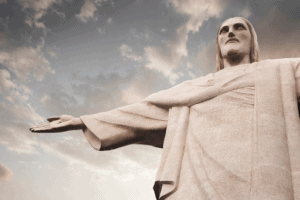Christ the Redeemer is World Renown
Rio de Janeiro has a large Catholic population dating back to the 16th century Portuguese colonists who brought the religion from Europe. Certainly, Christ the Redeemer is a beloved icon among locals. Of the 13.5 million residents, more than 51% identify as practicing Catholics.
It is perhaps not surprising, then, that the city’s most famous artwork is rooted in the Catholic faith. Known to Brazilians as “Cristo Redento,” the statue stands large and looming on a mountaintop, arms reaching out as if he were drawing the entire city into an embrace.
The imposing statue can be seen anywhere in the city. This is intentional, since its original purpose was to instill a sense of piety among straying Catholics. Even the non-religious can’t help but feel the gaze of the enormous Redeemer as they go about their business.
How Big Is the Christ the Redeemer Statue?
Built in the Art Deco style, the Redeemer is a masterpiece of sculpture and design. The statue weighs 635 metric tons and is 98 feet tall. The arms measure 92 feet in length, and the whole statue sits on top of a 26 foot pedestal.
Where Is the Statue Located?
Christ the Redeemer sits on the summit of Corcovado Mountain, a 2300 ft peak located in Tijuca Forest National Park. The idea of placing a statue on this mountain was first proposed by a local priest, Pedro Maria Boss. He suggested building a monument there to honor Princess Isabel, the regent of Brazil.
Father Pedro’s project was never approved and, in 1889, Brazil became a republic. The project was dismissed entirely to adhere to the separation of church and state.
Why Was the Statue Built?
In 1921, the Roman Catholic Archdiocese of Rio again proposed that a monument be built on top of Mount Corcovado. Catholic citizens petitioned then-president Epitacio Pessoa to allow for the construction of a statue of Christ. The petition was granted and the first stone was symbolically laid on April 4, 1922.
While the exact reason for the statue is unknown, the predominant theory is that the Church felt its subjects were straying from their faith. A monumental figure of Christ that could be seen from anywhere in the city would be a not-too-subtle reminder of their duties to God.
Who Built It and When?
Christ the Redeemer’s design was initially conceived by Brazilian engineer Heitor da Silva Costa, whose sketches showed Christ holding a cross in one hand and the world in the other. This design was refined by Carlos Oswald, another Brazilian artist who is credited with the idea of having Christ’s arms outstretched.
French sculptor Paul Landowski collaborated with da Silva Costa and Oswald on the statue and commissioned Gheorge Leonida of Romania to work on the details of the face and head.
The massive size of the statue required that it be built on site. All materials and workers were transported via a small cog train that led to the summit. This was a complicated and expensive undertaking. The final cost of building the statue was around $250,000, which is the equivalent of over $3 million today. It was funded almost entirely through private donations to the Catholic Church.
The statue was completed on October 12, 1931. It has undergone periodic cleanings and renovations, the most recent of which was in 2010 after a lightning storm caused significant damage.
What is Cristo Redentor Made Of?
The sculpture is built with reinforced concrete and decorated in a mosaic of soapstone, a metamorphic rock mined locally in Brazil. It is durable and easy to carve due to its high talc content. It is also heat tolerant, which is why it is sometimes used to line fireplaces. More often, it is used for things like countertops and flooring.
Who Can Visit the Statue?
Anyone is welcome to visit the monument. Tourists can get a better view using the escalators and panoramic elevators that have been added to spare visitors the 200-step climb to the top.
Today, there is also a chapel consecrated in 2006 to Our Lady of Apparition-the patron saint of Rio. The chapel is located at the base of the Redeemer statue and is a popular venue for weddings and baptisms.
More than a Sculpture

Christ the Redeemer has become a symbol not just of Rio de Janeiro but of the entire country of Brazil. The statue is a reminder of the omnipresence of the Church for millions of citizens, and a testament to Brazilian engineering and design. It remains the largest Art Deco sculpture in the world and draws thousands of tourists and pilgrims every year.
Experience Brazilian Culture at Texas de Brazil
Outside of Brazil, one of the best ways to sample Brazilian culture is to visit one of our restaurants. We serve authentic Brazilian churrasco in the traditional gaucho way. Visit one of our 50+ locations for a dining experience unlike any other.
You can also subscribe to our blog for more interesting articles on Brazilian culture, history, and cuisine.
